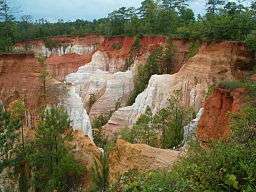Providence Canyon State Park
| Providence Canyon State Park (Little Grand Canyon) | |
| Georgia State Park | |
 Providence Canyon, from the rim | |
| Country | US |
|---|---|
| State | Georgia |
| County | Stewart County |
| Location | Lumpkin |
| - elevation | 500 ft (152 m) |
| - coordinates | 32°03′48″N 84°55′10″W / 32.063273°N 84.919511°WCoordinates: 32°03′48″N 84°55′10″W / 32.063273°N 84.919511°W |
| Area | 1,003 acres (406 ha) |
| IUCN category | III - Natural Monument |
|
Location of Providence Canyon State Park in Georgia
| |
Providence Canyon State Park is a 1,003 acres (4.06 km2; 1.57 sq mi) state park located in Stewart County in southwest Georgia.[1] The park contains Providence Canyon, which is sometimes called Georgia's "Little Grand Canyon". It is considered to be one of the Seven Natural Wonders of Georgia. Providence Canyon actually is not a purely natural feature — the massive gullies (the deepest being 150 feet) were caused by erosion due to poor farming practices in the 19th century. It is also home to the very rare plumleaf azalea.
This old story of the origin of the canyons has been commonplace since the 1940s. Although there were probably a few early arrivals before 1825, the first heavy influx of settlers in Stewart county came after the Treaty of Indian Springs (1825) by which the Creek Indians ceded all their lands east of the Chattahoochee river. Evidence of the existence of the canyons is their mention in a deed by James S Lunsford to William Tatam recorded in 1836.
The park lies on marine sediments—usually loamy or clayey, with small areas of sand. Loamy sand topsoils overlie subsoils of sandy clay loam, sandy clay, or clay in most of the uneroded section. Nankin, Cowarts, Mobila, and Orangeburg are the most prominent soil series. The canyons have much exposure of clay, over which water often seeps. Water is mobile in this well drained area.
One of the quirkier attractions of the state park is an abandoned homestead including nearly a dozen rusty, 1950s-era cars and trucks. Due to the environmental damage that removing the vehicles would cause, park officials have decided to leave them alone.
Facilities
- 1,003 acres
- 2 picnic shelters
- 6 back country campsites
- 3 pioneer campsites
Yearly events
- Christmas Workshop (December)
- Astronomy Night (September)
- Fall Wildflower Day (October)
- Geology Day (October)
Images
 entrance sign
entrance sign Providence Methodist Church
Providence Methodist Church interior of Providence Methodist Church
interior of Providence Methodist Church view from canyon rim
view from canyon rim view from the canyon floor
view from the canyon floor informational sign
informational sign junked car
junked car 1950s-era car
1950s-era car
References
- ↑ "Providence Canyon State Park Official Website". Retrieved 6 July 2011.
External links
| Wikimedia Commons has media related to Providence Canyon State Park. |
- Anonymous (nda) Providence Canyon - Georgia State Parks and Historic Sites. (trail map) State Parks and Historic Sites, Georgia Department of Natural Resources, Cartersville, Georgia. Retrieved 16 February 2013.
- Anonymous (ndb) Scholl Science Programs at Providence Canyon Outdoor Recreational Area. State Parks and Historic Sites, Georgia Department of Natural Resources, Cartersville, Georgia. Retrieved 16 February 2013.
- Anonymous (ndc) Providence Canyon State Park Trail (Map). Tons of Fun, State Parks and Historic Sites, Georgia Department of Natural Resources, Cartersville, Georgia. Retrieved 16 February 2013.
- Bieler, K. M., and J. A. Hyatt (2007) Defining Down-Valley Stratigraphic Records of Human Induced Canyons in southwest Georgia. Department of Environmental Earth Science, Eastern Connecticut State University, Willimantic, Connecticut. Retrieved 16 February 2013.
- Coastal Living Editor (2008) A Tree Grows Through an Abandoned Truck at Providence Canyon State Park. Southern Living, Time Inc. Lifestyle Group. Retrieved 16 February 2013.
- Hyatt, J. A. (nd) Art and Science of Providence Canyon State Park in SW GA. Department of Environmental Earth Science, Eastern Connecticut State University, Willimantic, Connecticut. Retrieved 16 February 2013.
- Nicoulin, A., J. A. Hyatt and P. Drzewiecki (2010) Comparison of Vibracore Records of Massive Human-Induced Erosion at Providence Canyon State Park in Southwest Georgia. Department of Environmental Earth Science, Eastern Connecticut State University, Willimantic, Connecticut. Retrieved 16 February 2013.
- Nicoulin, A., J. A. Hyatt and P. Drzewiecki (nd) Comparison of Vibracore Records of Massive Human-Induced Erosion at Providence Canyon State Park in Southwest Georgia. (poster), Connecticut Science Center, Eastern Connecticut State University, Willimantic, Connecticut. Retrieved 16 February 2013.
- Ostrowski, T. J., and J. A. Hyatt (2004) Research on Sedimentary Records of Human Induced Erosion in Stewart County, South Georgia. Department of Environmental Earth Science, Eastern Connecticut State University, Willimantic, Connecticut. Retrieved 16 February 2013.
- Sutter, P.S. (2010) What Gullies Mean: Georgia's "Little Grand Canyon" and Southern Environmental History. Journal of Southern History. vol. LXXVI, no. 3, pp. 579–616. Retrieved 16 February 2013.